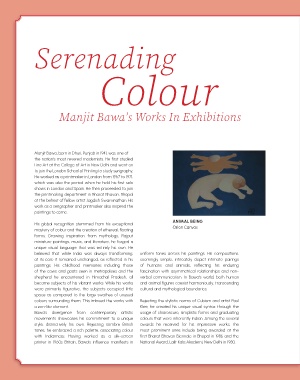Page 167 - AstaGuru Modern Odyssey
P. 167
Serenading
Colour
Manjit Bawa’s Works In Exhibitions
Manjit Bawa, born in Dhuri, Punjab in 1941, was one of
the nation’s most revered modernists. He first studied
Fine Art at the College of Art in New Delhi and went on
to join the London School of Printing to study serigraphy.
He worked as a printmaker in London from 1967 to 1971,
which was also the period when he held his first solo
shows in London and Spain. He then proceeded to join
the printmaking department in Bharat Bhavan, Bhopal
at the behest of fellow artist Jagdish Swaminathan. His
work as a serigrapher and printmaker also inspired the
paintings to come.
ANIMAL BEING
His global recognition stemmed from his exceptional
mastery of colour and the creation of ethereal, floating Oil on Canvas
forms. Drawing inspiration from mythology, Rajput
miniature paintings, music, and literature, he forged a
unique visual language that was entirely his own. He
believed that while India was always transforming, uniform tones across his paintings. His compositions,
at its core it remained unchanged, as reflected in his seemingly simple, intricately depict intimate pairings
paintings. His childhood memories including those of humans and animals, reflecting his enduring
of the cows and goats seen in metropolises and the fascination with asymmetrical relationships and non-
shepherd he encountered in Himachal Pradesh, all verbal communication. In Bawa’s world, both human
became subjects of his vibrant works. While his works and animal figures coexist harmoniously, transcending
were primarily figurative, the subjects occupied little cultural and mythological boundaries.
space as compared to the large swathes of unusual
colours surrounding them. This imbued the works with Rejecting the stylistic norms of Cubism and artist Paul
a zen-like element. Klee, he created his unique visual syntax through the
Bawa’s divergence from contemporary artistic usage of chiaroscuro, simplistic forms and graduating
movements showcases his commitment to a unique colours that were inherently Indian. Among the several
style, distinctively his own. Rejecting sombre British awards he received for his impressive works, the
tones, he embraced a rich palette, associating colour most prominent ones include being awarded at the
with Indianness. Having worked as a silk-screen first Bharat Bhavan Biennale in Bhopal in 1986 and the
printer in 1960s Britain, Bawa’s influence manifests in National Award, Lalit Kala Akademi, New Delhi in 1980.

